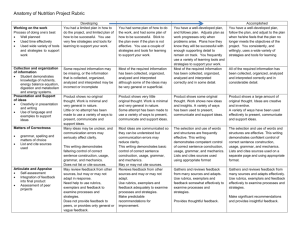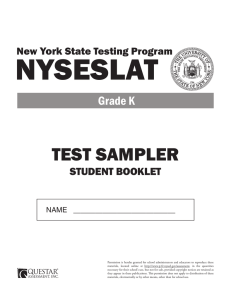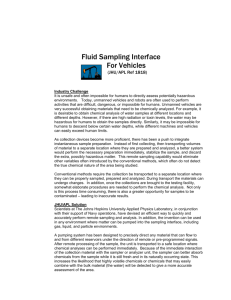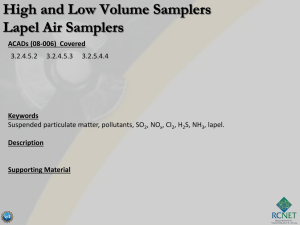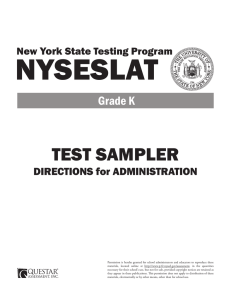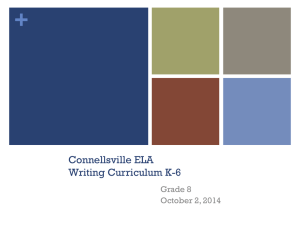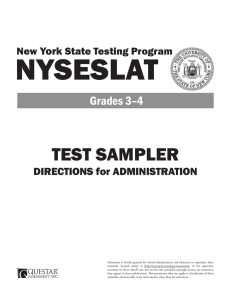NYSESLAT TEST SAMPLER Grades 7–8 York
advertisement
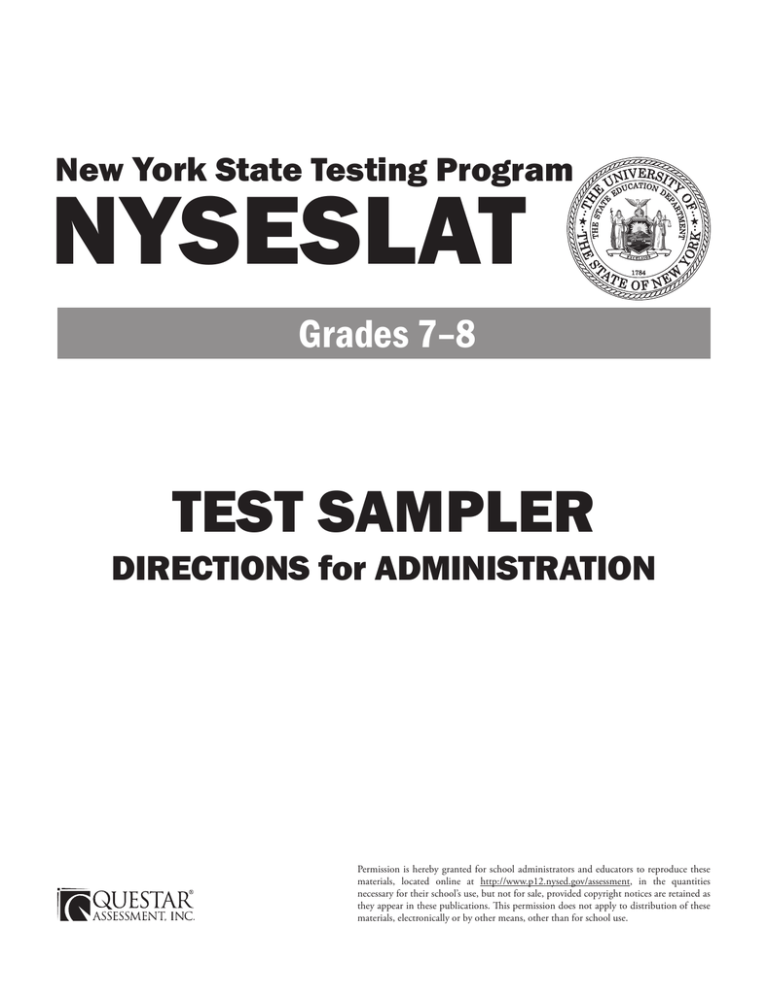
New York State Testing Program NYSESLAT Grades 7–8 TEST SAMPLER DIRECTIONS for ADMINISTRATION Permission is hereby granted for school administrators and educators to reproduce these materials, located online at http://www.p12.nysed.gov/assessment, in the quantities necessary for their school’s use, but not for sale, provided copyright notices are retained as they appear in these publications. This permission does not apply to distribution of these materials, electronically or by other means, other than for school use. Table of Contents Introduction to the Test Sampler.........................................................................................3 Directions for Administering the Test Sampler ................................................................4 Speaking Test ................................................................................................................. 5 Listening Test................................................................................................................. 7 Reading Test................................................................................................................. 10 Writing Test ................................................................................................................. 11 Question Key ......................................................................................................................... 14 Speaking Rubrics, Scoring Forms, and Exemplars........................................................ 15 Writing Rubrics, Scoring Forms, and Exemplars ........................................................... 25 2 NYSESLAT 7–8 SLRW DFA Sampler Copyright © 2013 by New York State Education Department. Introduction to the Test Sampler The NYSESLAT Test Sampler consists of three separate sets of materials: • Student Booklets (one for each grade band), • Directions for Administration (one for each grade band), and • Guide to the 2013 NYSESLAT. The purpose of the Test Sampler materials is to introduce teachers, test administrators, and students to the directions and types of questions that appear on the New York State English as a Second Language Achievement Test (NYSESLAT). In addition to the sample test administrator script, these Directions for Administration contain the Speaking and Writing rubrics that will be used in scoring the NYSESLAT and examples of student responses to the open-ended questions in the Speaking and Writing sections. The Student Booklets and Directions for Administration together can be used to “administer” the Test Sampler to students as a way of introducing them to and preparing them for taking the actual test. In particular, the Test Sampler can be used to help students become familiar with the mechanics of using a scannable answer sheet. This is a good time to make sure students understand the procedures for filling in the circles for answer choices: • filling in the circle completely, • not filling in more than one circle per question, and • thoroughly erasing any responses they wish to change. Since the Sampler is for practice purposes only, students may be given as much help as they need to complete the questions and the answer sheet successfully. It is recommended that the Sampler be administered to students approximately one week before the regular NYSESLAT administration. The Guide to the 2013 NYSESLAT provides more in-depth and technical information about the question types and the specifications for the NYSESLAT. The Guide also makes specific reference to the questions in the Test Sampler Student Booklets. Please make sure to visit the Office of State Assessment Web site for all updates regarding the NYSESLAT: http://www.p12.nysed.gov/assessment/nyseslat. 3 Copyright © 2013 by New York State Education Department. NYSESLAT 7–8 SLRW DFA Sampler Directions for Administering the Test Sampler To administer the Sampler as a practice test, read aloud the boldfaced text next to the word “SAY.” Instructions for the test administrator are printed in plain text and should not be read aloud to the students. SAY Today we are going to do some practice questions. I am going to give each of you a booklet. Write your name on the front of the booklet, but do not open your booklet until I tell you to do so. Distribute the Sampler Student Booklets with the front covers facing up. Be sure each student has a booklet and a pencil with an eraser. SAY Remove the answer sheet from your booklet. (Demonstrate.) Write your name at the top of the page. Make sure the answer sheet is facing up. You will mark the answers to some of the questions on this answer sheet. There are numbered answer spaces for each question. Make sure all students have properly detached the answer sheet. SAY When you mark your answers remember this: • • • • Fill in the circle completely. (Illustrate on the chalkboard if necessary.) Fill in only one circle per question. If you fill in more than one circle, your answer will not count. If you change your mind about an answer, erase it completely. Do not make any stray marks on your answer sheet. Does everyone understand how to fill in the circles? Do you have any questions? Answer any questions the students may have about marking their answer sheets. 4 NYSESLAT 7–8 SLRW DFA Sampler Copyright © 2013 by New York State Education Department. SPEAKING IMPORTANT NOTE The Speaking Sampler, like the actual Speaking Test, is individually administered. Each student will need his or her Sampler Student Booklet to view the Speaking questions when taking the test. The teacher may reproduce the Speaking rubrics and scoring forms, located on pages 15–24 in this booklet, to use when scoring a student’s responses. Speaking scores may also be recorded on the Score Sheet at the back of the Student Booklet. It is important to review and become thoroughly familiar with the rubrics prior to the administration of the Speaking Sampler. Note that during actual test administration, the Speaking prompts may not be repeated. SAY Open your booklet to page 2. This is the Speaking section. Make sure the student has the Student Booklet open to page 2. Prepare to score the Speaking section using the Sampler Speaking rubrics and scoring forms. SAY Look at the top of the page. Read the directions to yourself as I read them out loud. Directions: I will say something to you. Listen and then answer. SAY 1 Look at number 1. Tell me about something you learned in science class last week. Pause for about 15 seconds for the student to respond. SAY Now look at the top of page 3. Read the directions to yourself as I read them out loud. Directions: Look at the words above the picture, and read them silently as I read them out loud. Then look at the picture and finish the sentence. Use the picture to choose your words. SAY 2 Look at number 2. Mei is studying ecosystems in school, so she . . . Pause for about 15 seconds for the student to respond. Score the response. SAY Please turn the page. Look at the top of page 4. Read the directions to yourself as I read them out loud. Directions: Look at the picture. Listen to the question about the picture. Then answer the question. Be sure to answer both parts of the question. 5 Copyright © 2013 by New York State Education Department. NYSESLAT 7–8 SLRW DFA Sampler Speaking SAY 3 Look at number 3. What is the man doing, and why? Pause for about 15 seconds for the student to respond. SAY Look at the top of page 5. Read the directions to yourself as I read them out loud. Directions: Look carefully at the map. Answer the questions based on the information provided. SAY 4 Look at number 4. What does this map show? (Pause for about 15 seconds for the student to respond.) Based on the map, explain how to get from the Ferris wheel to the roller coaster. If the student responds by simply pointing, say “Tell me without using your finger.” Pause for about 15 seconds for the student to respond. SAY SAY 5 Please turn the page. Look at the three pictures in number 5. Tell a story about what you see in the pictures. Think about your story before you begin. Include as many details as you can. You may name the characters in your story. Tell what happened first, what happened next, and what happened last. You may begin when you are ready. Allow the student as much time as he or she needs to respond. SAY This is the end of the Speaking section. Do you have any questions about the Speaking section? Answer any questions the student may have. 6 NYSESLAT 7–8 SLRW DFA Sampler Copyright © 2013 by New York State Education Department. LISTENING IMPORTANT NOTE In this Sampler, the teacher reads the boldfaced text. In the NYSESLAT Operational Test for Grades 3–12, the Listening subtest is administered using a CD. SAY Look at the top of page 7. This is the Listening section. Make sure all students have found the Listening section. SAY There are some directions at the top of the page. Read them to yourself as I read them out loud. Directions: Listen to the question. Find the picture that answers the question. Fill in the correct circle on your answer sheet. SAY 1 Look at number 1. Which picture shows astonishment? . . . Which picture shows astonishment? Pause for about 10 seconds. SAY Please turn the page. Look at the top of page 8. Read the directions to yourself as I read \ them out loud. \ You will hear a brief story or conversation. Then read the question and Directions: answers silently as I read them out loud. Fill in the correct circle on your answer \ sheet. \ \ \ \ You will only have a chance to hear the person talking one time, so listen carefully. \ \ \ \ \ \ \ \ \ \ 7 Copyright © 2013 by New York State Education Department. NYSESLAT 7–8 SLRW DFA Sampler Listening SAY You will hear a teacher talking. Now listen. “Today we are going to discuss similes. A simile is a type of figurative language that compares two things. It uses the words ‘like’ or ‘as.’ I’m going to read aloud a paragraph from a personal narrative. Listen for similes, and write down any that you hear. Then, get in your groups and discuss what the writer means by these similes and whether you think his use of figurative language is effective or not.” Pause. SAY 2 Look at number 2. What will you do with your group? A B C D Copy figurative language Talk about similes Listen to a narrative Read a paragraph Pause for about 10 seconds. SAY Look at the top of page 9. Read the directions to yourself as I read them out loud. Directions: You will hear a lesson. I will read the lesson twice. After you hear the lesson, you will answer several questions about it, so listen carefully. As you listen carefully, you may take notes on the lesson anytime you wish during the two readings. You may use these notes to answer the questions that follow. Use the blank space on this page for notetaking. Your notes on this page will NOT be scored. Do NOT turn the page until I tell you to do so. 8 NYSESLAT 7–8 SLRW DFA Sampler Copyright © 2013 by New York State Education Department. Listening SAY Now you will hear a social studies lesson. Listen carefully. The game of Double Dutch jump rope was first played in America on the streets of New Amsterdam. Dutch settlers brought it with them across the sea. But the game did not originate with the Dutch. It is believed to have begun in ancient times. In ancient Phoenicia and Egypt, rope was very important to sailors. It was made of a plant fiber, and it was used on ships to rig sails and tie down cargo. Rope makers worked at seaports, tying the ends of the fiber strands to a wheel, and then walking backward as they twisted the strands into rope. Runners would bring the rope makers more fiber when they needed it. They would have to jump over the twisting strands to make their deliveries. This probably led to the idea for making rope jumping a game. The fancy footwork needed to jump between two turning ropes was passed down over generations. Dutch traders saw the game and brought it home with them to the Netherlands. Pause. SAY Now you will hear the lesson again. (Repeat the lesson.) SAY SAY 3 Now please turn the page. Look at number 3. What is this lesson mainly about? A B C D Dutch trade with Egypt How to play Double Dutch jump rope Dutch settlements in New Amsterdam The history of a jump rope game Pause for about 10 seconds. SAY 4 Look at number 4. According to the lesson, which group brought jump rope to America? A B C D The Egyptians The Phoenicians The Dutch The Native American Indians Pause for about 10 seconds. SAY This is the end of the Listening section. Does anyone have any questions about the Listening section? Answer any questions the students may have. 9 Copyright © 2013 by New York State Education Department. NYSESLAT 7–8 SLRW DFA Sampler READING SAY Now turn to page 12. This is the Reading section. Make sure all students have found the Reading section. SAY Read the directions to yourself as I read them out loud. Directions: Read the passage. Then answer the questions. Fill in the correct circle on your answer sheet. 1–5 You will do questions 1 through 5 by yourself. When you have finished question 5, stop, put your pencil down, and look up. You may begin now. When all students have finished number 5, SAY This is the end of the Reading section. Does anyone have any questions about the Reading section? Answer any questions the students may have. 10 NYSESLAT 7–8 SLRW DFA Sampler Copyright © 2013 by New York State Education Department. WRITING SAY Now turn to page 16. This is the Writing section. Make sure all students have found the Writing section. SAY Look at the directions at the top of the page. Read the directions to yourself as I read them out loud. Directions: Read the question and four answers. Fill in the correct circle on your answer sheet. 1–2 You will do questions 1 and 2 by yourself. When you have finished question 2, stop, put your pencil down, and look up. You may begin now. When all students have finished number 2, SAY Look at the top of page 17. Read the directions to yourself as I read them out loud. Directions: Read the sentence and look at the underlined part. There may be a mistake. If you find a mistake, choose the correct answer. If there is no mistake, choose Correct as is. Fill in the correct circle on your answer sheet. 3–4 You will do questions 3 and 4 by yourself. When you have finished question 4, stop, put your pencil down, and look up. You may begin now. When all students have finished number 4, SAY Please turn the page. Look at the top of page 18. Read the directions to yourself as I read them out loud. 11 Copyright © 2013 by New York State Education Department. NYSESLAT 7–8 SLRW DFA Sampler Writing 5 Directions: Write a paragraph that describes what is happening in the picture. Include as many details as you can. Someone who reads your paragraph should be able to imagine the entire scene. Before you start writing, look at the picture carefully and think about the following: • What is the setting? • Who is the person, and what is she doing? • What might the person be thinking or feeling? Look at page 19 in your booklet. (Hold up Student Booklet and point to page 19.) This is where you will write your paragraph. There is a Writing Checklist at the top of the page. Use this checklist to check your work. (Point to the Writing Checklist.) The checklist says: • • • • • • Write one paragraph about the picture. Write a topic sentence. Use details in your writing. Use complete sentences. Write a concluding sentence. Check your work for capitalization, punctuation, and spelling. As soon as you are finished, put your pencil down and look up. You may begin now. When all students have finished writing, SAY Stop. Please turn the page. Look at the top of page 20. Read the directions to yourself as I read them out loud. 12 NYSESLAT 7–8 SLRW DFA Sampler Copyright © 2013 by New York State Education Department. SAY 6 Writing Directions: Look at the information about Cheyenne and Chicago in the chart and map. If this were the year 1877, where would you rather live—in Cheyenne, a frontier town in the western part of the United States, or in Chicago, a large midwestern city? In your own words, write a well-organized essay about in which place you would rather live in 1877. In your essay, remember to: • • • • Include an introduction, body, and conclusion. Use information from both the chart and the map. Include details, examples, or reasons. Use your own words. You may also include other information that you know about this topic. Look at page 22 in your booklet. Use this blank Planning Page to take notes and plan your writing. (Hold up Student Booklet and point to page 22.) What you write on the Planning Page will not be scored. Write your essay on pages 23 and 24. (Point to the correct pages.) There is a Writing Checklist at the top of page 23. Use this checklist to check your work. (Point to the Writing Checklist.) The checklist says: • • • • • Write about the topic. Include an introduction, body, and conclusion. Include details, examples, or reasons. Use complete sentences and paragraphs. Use correct grammar, punctuation, and spelling. Do not copy any complete sentences directly from the chart. Use your own words. You may begin now. Allow students as much time as they need to write their essays. When all students have finished writing, SAY Stop. This is the end of the Writing section. Does anyone have any questions about the Writing section? Answer any questions the students may have. Collect the booklets and answer sheets from the students. This concludes the Sampler. The teacher may reproduce the Writing rubrics and scoring forms, located on pages 25–42 in this booklet, to use when scoring a student’s responses to the questions in the Test Sampler. Writing scores may be recorded on the Score Sheet at the back of the Student Booklet. 13 Copyright © 2013 by New York State Education Department. NYSESLAT 7–8 SLRW DFA Sampler GRADES 7–8 TEST SAMPLER QUESTION KEY Listening 1. C 2. B 3. D 4. C Reading 1. D 2. D 3. B 4. D 5. C Writing 1. A 2. B 3. A 4. D 14 NYSESLAT 7–8 SLRW DFA Sampler Copyright © 2013 by New York State Education Department. Speaking Rubrics, Scoring Forms, and Exemplars Student Name: Sampler Social & Academic Interaction Rubric and Scoring Form Directions: Use this rubric and scoring form to score the Social & Academic Interaction question. After the student responds to the question, enter the appropriate score in the box provided below or on the Score Sheet at the back of the Student Booklet. Exemplars of scored responses are provided as a reference. Question Number Score 1 Social & Academic Interaction Relevant response that approximates grade-level fluency • Ideas are expressed clearly and effectively Score Point 2 • Uses vocabulary that is context-related and precise (accurately uses general academic and domain-specific words as appropriate) • Demonstrates command of the conventions of standard English grammar and usage Relevant response that falls below grade-level fluency • Ideas are expressed somewhat clearly or effectively Score Point 1 • Uses overly simplified vocabulary • Demonstrates only partial command of the conventions of standard English grammar and usage Irrelevant or unintelligible response • Is incoherent Score Point 0 • Solely in a language other than English • Only repeats the prompt • Minimal or no response 15 Copyright © 2013 by New York State Education Department. NYSESLAT 7–8 SLRW DFA Sampler Speaking Rubrics, Scoring Forms, and Exemplars Social & Academic Interaction Exemplars Question Prompt Transcription I learned about chemical reactions. 1 Tell me about something you learned in science class last week. What are the name of some chemicals? 1 Tell me about something you learned in science class last week. Tell me about something you learned in science class last week. What umm, what do you learning, the, last week, ah science, um what, what you learning in last week science? 1 Score Comment 2 Ideas are expressed clearly and effectively; uses vocabulary that is context-related and precise; demonstrates command of the conventions of standard English grammar and usage. 1 Ideas are expressed somewhat clearly; demonstrates only partial command of the conventions of standard English grammar and usage. Only repeats the prompt. 0 16 NYSESLAT 7–8 SLRW DFA Sampler Copyright © 2013 by New York State Education Department. Speaking Rubrics, Scoring Forms, and Exemplars Student Name: Sampler Sentence Completion Rubric and Scoring Form Directions: Use this rubric and scoring form to score the Sentence Completion question. After the student responds to the question, enter the appropriate score in the box provided below or on the Score Sheet at the back of the Student Booklet. Exemplars of scored responses are provided as a reference. Question Number Score 2 Sentence Completion Relevant response that approximates grade-level fluency • Appropriately describes the person, thing, or event in the graphic Score Point 2 • Uses vocabulary that is context-related and precise (accurately uses general academic and domain-specific words as appropriate) • Demonstrates command of the conventions of standard English grammar and usage (i.e., uses correct verb tense, subject-verb agreement) Relevant response that falls below grade-level fluency • Somewhat appropriately describes the person, thing, or event in the graphic Score Point 1 • Uses overly simplified vocabulary • Demonstrates only partial command of the conventions of standard English grammar and usage (e.g., may contain errors in verb tense or subject-verb agreement), but is still intelligible Irrelevant or unintelligible response • Is incoherent Score Point 0 • Solely in a language other than English • Only repeats the prompt • Minimal or no response 17 Copyright © 2013 by New York State Education Department. NYSESLAT 7–8 SLRW DFA Sampler Speaking Rubrics, Scoring Forms, and Exemplars Sentence Completion Exemplars Question Prompt Mei is studying ecosystems in school, so she . . . Transcription Mei is studying ecosystems in school, so she . . . 2 Appropriately describes the event in the graphic; uses vocabulary that is context-related and precise; demonstrates command of the conventions of standard English grammar and usage. 1 Somewhat appropriately describes the event in the graphic; demonstrates only partial command of the conventions of standard English and grammar usage. um, look around and take notes. 2 2 Comment went outside and jotted some notes. 2 Mei is studying ecosystems in school, so she . . . Score um, the so she can help the, the, the there? 0 Irrelevant response. 18 NYSESLAT 7–8 SLRW DFA Sampler Copyright © 2013 by New York State Education Department. Speaking Rubrics, Scoring Forms, and Exemplars Student Name: Sampler Picture Description Rubric and Scoring Form Directions: Use this rubric and scoring form to score the Picture Description question. After the student responds to the question, enter the appropriate score in the box provided below or on the Score Sheet at the back of the Student Booklet. Exemplars of scored responses are provided as a reference. Question Number Score 3 Picture Description Relevant response that approximates grade-level fluency • Is complete (i.e., addresses both parts of the oral prompt) • Appropriately integrates and evaluates the visual information (i.e., is plausible) Score Point 2 • Ideas are expressed clearly (i.e., response is coherent and cohesive) • Uses vocabulary that is context-related and precise (accurately uses general academic and domain-specific words as appropriate for the task) • Demonstrates command of the conventions of standard English grammar and usage Relevant response that falls below grade-level fluency • Addresses only part of the prompt Score Point 1 • Somewhat integrates and evaluates the visual information (i.e., is partially plausible) • Ideas are expressed somewhat clearly • Uses overly simplified vocabulary • Demonstrates only partial command of the conventions of standard English grammar and usage Irrelevant or unintelligible response • Does not address the prompt Score Point 0 • Is incoherent • Solely in a language other than English • Only repeats the prompt • Minimal or no response 19 Copyright © 2013 by New York State Education Department. NYSESLAT 7–8 SLRW DFA Sampler Speaking Rubrics, Scoring Forms, and Exemplars Picture Description Exemplars Question Prompt What is the man doing, and why? Transcription 3 3 What is the man doing, and why? Comment 2 Addresses both parts of the prompt; appropriately integrates and evaluates the visual information; ideas are expressed clearly and effectively; uses vocabulary that is context-related and precise; demonstrates command of the conventions of standard English grammar and usage. 1 Response falls below grade-level fluency; demonstrates only partial command of the conventions of standard English grammar and usage. The man is painting his house because he is going to have visitors next week. 3 What is the man doing, and why? Score The man was doing the painting because is this is was, what was working for the owner. Man is um, like, um, her house is like break, she's like is breaking, he, he is doing a round. 0 Irrelevant response; does not address the prompt. 20 NYSESLAT 7–8 SLRW DFA Sampler Copyright © 2013 by New York State Education Department. Speaking Rubrics, Scoring Forms, and Exemplars Student Name: Sampler Response to Graphic Information Rubric and Scoring Form Directions: Use this rubric and scoring form to score the Response to Graphic Information question. After the student responds to the question, enter the appropriate score in the box provided below or on the Score Sheet at the back of the Student Booklet. Exemplars of scored responses are provided as a reference. Question Number Score 4 Response to Graphic Information Relevant response that approximates grade-level fluency • Is complete (i.e., addresses both parts of the oral prompt) • Appropriately integrates and evaluates the graphic information (i.e., response is accurate) Score Point 2 • Ideas are expressed clearly (i.e., response is coherent and cohesive) • Uses vocabulary that is context-related and precise (accurately uses general academic and domain-specific words as appropriate to the task) • Demonstrates command of the conventions of standard English grammar and usage Relevant but incomplete response that falls below grade-level fluency • Addresses only part of the prompt • Partially misinterprets the graphic information Score Point 1 • Ideas are expressed somewhat clearly • Uses overly simplified vocabulary • Demonstrates only partial command of the conventions of standard English grammar and usage Irrelevant or invalid response • Completely misinterprets the graphic information Score Point 0 • Is incoherent • Solely in a language other than English • Only repeats the prompt • Minimal or no response 21 Copyright © 2013 by New York State Education Department. NYSESLAT 7–8 SLRW DFA Sampler Speaking Rubrics, Scoring Forms, and Exemplars Response to Graphic Information Exemplars Question Prompt What does this map show? 4 4 4 Based on the map, explain how to get from the Ferris wheel to the roller coaster. Transcription Score Part 1: The map shows different places in the, um carnival. Part 2: Um, from the Ferris wheel to the roller coaster you could go north then east, around the, the park, and then go east, and then go north again. What does this map show? Part 1: Um, it show pakr, park. Based on the map, explain how to get from the Ferris wheel to the roller coaster. Part 2: Um you have to go straight and then, you have to go right. What does this map show? Part 1: He got water. . . uh food. . . how. Based on the map, explain how to get from the Ferris wheel to the roller coaster. Part 2: Hmm. . . I don’t know. Comment Addresses both parts of the prompt; ideas are expressed clearly; uses vocabulary that is context-related. 2 1 Partially misinterprets the graphic information; ideas are expressed somewhat clearly; uses overly simplified vocabulary. Irrelevant response; misinterprets the graphic. 0 22 NYSESLAT 7–8 SLRW DFA Sampler Copyright © 2013 by New York State Education Department. Speaking Rubrics, Scoring Forms, and Exemplars Student Name: Sampler Storytelling Rubric and Scoring Form Directions: Use this rubric and scoring form to score the Storytelling question. After the student responds to the question, enter the appropriate score in the box provided below or on the Score Sheet at the back of the Student Booklet. Exemplars of scored responses are provided as a reference. Question Number Score 5 Storytelling Native-like fluent response • Is well organized and logically developed Score Point 4 • Includes many relevant and descriptive details and task-appropriate vocabulary • Uses coherent, fluent sentences • Speech is clear and pace is appropriate Slightly below native-like fluency • Is somewhat organized and developed Score Point 3 • Includes some relevant details and mostly task-appropriate vocabulary • Uses mostly coherent, fluent sentences • Speech may not be entirely clear; pace may be somewhat slow Considerably below native-like fluency • Is poorly organized Score Point 2 • Includes few details; vocabulary is overly simplified • Uses some coherent sentences • Speech is somewhat difficult to understand; may be slow and halting Very limited fluency • Is not organized Score Point 1 • Includes very limited vocabulary • May be limited to phrases rather than sentences • Speech is difficult to understand No fluency demonstrated • Completely irrelevant or incoherent Score Point 0 • Solely in a language other than English • Only repeats the prompt • Minimal or no response 23 Copyright © 2013 by New York State Education Department. NYSESLAT 7–8 SLRW DFA Sampler Speaking Rubrics, Scoring Forms, and Exemplars Storytelling Exemplars Question Prompt Look at the three pictures. Tell a story about what you see in the pictures. 5 Transcription Score First, Rosa was in the supermarket and she went to checkout when suspiciously she saw this golden, umm, bracelet. Next, she went to the cashier and told the man that she saw this bracelet. So she left it with the cashier to see if somebody else comes and, and picks it up. Last, the woman, the cashier tell the woman that she had left her bracelet here. The woman was happy that she found her bracelet and she went home knowing that she found it. Look at the three pictures. Tell a story about what you see in the pictures. In the first movie, the woman is walking by and she see a bracelet on the floor, on the floor. Next, she goes, she goes to the man, tellin her that she found the bracelet on the floor, floor. Then after that, last, the man who sells it, sells the bracelet to a, to a woman. 5 Look at the three pictures. Tell a story about what you see in the pictures. Mary found a, a jewelry. She gave it to John. Then she told John that sh, um, Mary found a jewelry on the floor. Next, and last, John gave it the jewelry to the, to someone who lost that. She’s picking up something, and, and some guy find it. 5 Look at the three pictures. Tell a story about what you see in the pictures. Ring. Ring, and ring 5 Look at the three pictures. Tell a story about what you see in the pictures. 5 4 Comment Well organized and logically developed; includes many relevant and descriptive details (supermarket, went to checkout, golden bracelet, left with cashier) and task-appropriate vocabulary; uses coherent, fluent sentences. 3 Somewhat organized; includes some relevant details (walking by, see a bracelet on the floor, man…sells the bracelet); speech is not entirely clear and pace is somewhat slow at times. 2 Includes few details; speech is somewhat difficult to understand and is slow and halting at times. 1 Demonstrates limited fluency; includes very limited vocabulary. Minimal response. 0 24 NYSESLAT 7–8 SLRW DFA Sampler Copyright © 2013 by New York State Education Department. Writing Rubrics, Scoring Forms, and Exemplars Student Name: Sampler Descriptive Writing Paragraph Rubric and Scoring Form Directions: After the student has completed the Descriptive Writing Paragraph, use the rubric below to score the student’s writing. Enter the score in the box provided below or on the Score Sheet at the back of the Student Booklet. Exemplars of scored responses are provided as a reference. Question Number Score 5 Descriptive Writing Paragraph The Response: • Addresses the task • Includes many and varied descriptive details Score Point 4 • Is clear, coherent, and well organized • Uses concrete words and phrases and sensory details • Demonstrates command of the conventions of standard English grammar, usage, capitalization, punctuation, and spelling The Response: • Mostly addresses the task • Includes some descriptive details Score Point 3 • Is mostly clear, coherent, and organized • Uses vocabulary that is mostly appropriate to the task • Demonstrates some command of the conventions of standard English grammar, usage, capitalization, punctuation, and spelling The Response: • Partially addresses the task • Includes a few descriptive details Score Point 2 • May lack clarity and coherence and/or be somewhat disorganized • May use basic vocabulary • Demonstrates limited command of the conventions of standard English grammar, usage, capitalization, punctuation, and spelling 25 Copyright © 2013 by New York State Education Department. NYSESLAT 7–8 SLRW DFA Sampler Writing Rubrics, Scoring Forms, and Exemplars Descriptive Writing Paragraph (continued) The Response: • Minimally addresses the task Score Point 1 • May be somewhat disorganized and incoherent • Uses vocabulary that is inappropriate or insufficient for the task • Demonstrates minimal command of the conventions of standard English grammar, usage, capitalization, punctuation, and spelling The Response: • Does not address the task • Is illegible Score Point 0 • Is incoherent • Is solely in a language other than English • Is irrelevant • No response 26 NYSESLAT 7–8 SLRW DFA Sampler Copyright © 2013 by New York State Education Department. Writing Rubrics, Scoring Forms, and Exemplars Descriptive Writing Paragraph Exemplars Descriptive Writing Paragraph • Addresses the task Score Point 4 • Includes many and varied descriptive details (My name is Cindy Wong; 18 years old and on my way to college; on a Fairy express train taking me from New York to UCLA in California; head filled with thoughts) • Is clear, coherent, and well organized • Uses concrete words and phrases and sensory details (the ride is going to be extreamly/extremely long; thought of a day so difficult; cutting loose from the thing that you/I love most in the world) 5 27 Copyright © 2013 by New York State Education Department. NYSESLAT 7–8 SLRW DFA Sampler Writing Rubrics, Scoring Forms, and Exemplars Descriptive Writing Paragraph • Mostly addresses the task Score Point 3 • Includes some descriptive details (sitting on a bus; enjoing/enjoying the beautiful view of nature; thinking about the happy and awsome/ awesome things happend/happened in her life; feel to become one with nature; bus quickly passes) • Is mostly clear, coherent, and organized • Demonstrates some command of the conventions of standard English grammar, usage, and spelling 5 28 NYSESLAT 7–8 SLRW DFA Sampler Copyright © 2013 by New York State Education Department. Writing Rubrics, Scoring Forms, and Exemplars Descriptive Writing Paragraph • Partially addresses the task Score Point 2 • Includes a few descriptive details (in a traing/train; person is a women/ woman; how nice is the viwe/view; see her laffing/laughing) • Demonstrates limited command of the conventions of standard English grammar, usage, capitalization, punctuation, and spelling 5 29 Copyright © 2013 by New York State Education Department. NYSESLAT 7–8 SLRW DFA Sampler Writing Rubrics, Scoring Forms, and Exemplars Descriptive Writing Paragraph • Minimally addresses the task Score Point 1 • Is somewhat incoherent (The Pinture: is blach.) • Demonstrates minimal command of the conventions of standard English grammar, usage, capitalization, punctuation, and spelling 5 30 NYSESLAT 7–8 SLRW DFA Sampler Copyright © 2013 by New York State Education Department. Writing Rubrics, Scoring Forms, and Exemplars Descriptive Writing Paragraph Score Point 0 • Does not address the task (partial copy of the prompt) 5 31 Copyright © 2013 by New York State Education Department. NYSESLAT 7–8 SLRW DFA Sampler Writing Rubrics, Scoring Forms, and Exemplars Student Name: Sampler Fact-Based Essay Rubric and Scoring Form Directions: After the student has completed the Fact-Based Essay, use the rubric below to score the student’s writing. Enter the score in the box provided below or on the Score Sheet at the back of the Student Booklet. Exemplars of scored responses are provided as a reference. Question Number Score 6 Fact-Based Essay The Response: • Addresses the task and includes reasons supported by relevant details from the source material provided Score Point 4 • Integrates information from the source material using student’s own words • Is clear, coherent, and well organized • Uses precise language and domain-specific vocabulary that is appropriate to the task • Demonstrates command of the conventions of standard English grammar, usage, capitalization, punctuation, and spelling The Response: • Mostly addresses the task and includes reasons supported by relevant details from the source material provided Score Point 3 • Mostly integrates information from the source material using student’s own words • Is mostly clear, coherent, and organized • Uses language and vocabulary that is mostly appropriate to the task • Demonstrates some command of the conventions of standard English grammar, usage, capitalization, punctuation, and spelling The Response: • Partially addresses the task and includes reasons supported by a few details from the source material provided Score Point 2 • Partially integrates information from the source material using student’s own words, but may be largely copied • May lack clarity and coherence and/or be somewhat disorganized • Uses some vocabulary that is inappropriate to the task • Demonstrates limited command of the conventions of standard English grammar, usage, capitalization, punctuation, and spelling 32 NYSESLAT 7–8 SLRW DFA Sampler Copyright © 2013 by New York State Education Department. Writing Rubrics, Scoring Forms, and Exemplars Fact-Based Essay (continued) Fact-Based Essay The Response: • Minimally addresses the task Score Point 1 • Is primarily copied from the source material with minimal use of student’s own words • Is somewhat incoherent and disorganized • Uses vocabulary that is inappropriate or insufficient for the task • Demonstrates minimal command of the conventions of standard English grammar, usage, capitalization, punctuation, and spelling The Response: • Does not address the task • Is illegible Score Point 0 • Is incoherent • Is solely in a language other than English • Is irrelevant • No response 33 Copyright © 2013 by New York State Education Department. NYSESLAT 7–8 SLRW DFA Sampler Writing Rubrics, Scoring Forms, and Exemplars Fact-Based Essay Exemplars Fact-Based Essay • Addresses the task and includes reasons supported by relevant details from the source material provided (because Chicago was stablished/ established in 1837 so that city had more time to modernicize/ modernize; had trains and horse-drawn cars as ways of transportation) • Integrates information from the source material using student’s own words Score Point 4 • Is clear, coherent, and well organized • Uses precise language and domain-specific vocabulary that is appropriate to the task (that city had more time to modernicize/modernize; in contrast to the town of Cheyenne; Ultimately, Chicago was a more modern city than the town of Chayenne/Cheyenne) • Demonstrates command of the conventions of standard English grammar, usage, capitalization, punctuation, and spelling 6 34 NYSESLAT 7–8 SLRW DFA Sampler Copyright © 2013 by New York State Education Department. Writing Rubrics, Scoring Forms, and Exemplars 35 Copyright © 2013 by New York State Education Department. NYSESLAT 7–8 SLRW DFA Sampler Writing Rubrics, Scoring Forms, and Exemplars Fact-Based Essay • Mostly addresses the task and includes reasons supported by relevant details from the source material provided (chicago because there are telephones; because chicago is right next to a lake; they do have Public libaray’s/libraries) Score Point 3 • Mostly integrates information from the source material using student’s own words • Is mostly clear, coherent, and organized • Uses language and vocabulary that is mostly appropriate to the task (I will rather live in Chicago) • Demonstrates some command of the conventions of standard English grammar, usage, capitalization, punctuation, and spelling 6 36 NYSESLAT 7–8 SLRW DFA Sampler Copyright © 2013 by New York State Education Department. Writing Rubrics, Scoring Forms, and Exemplars 37 Copyright © 2013 by New York State Education Department. NYSESLAT 7–8 SLRW DFA Sampler Writing Rubrics, Scoring Forms, and Exemplars Fact-Based Essay Score Point 2 • Partially addresses the task and includes reasons supported by a few details in the source material provided (Cheyenne is new/newer then/ than Chicago; In Cheyenne They have Train Postol/postal servise/ service; dont/don’t have to/too much/many people living in there; in Chicago is more cold because Chicago is closer to the michigan like/ lake) • Lacks clarity and coherence and is somewhat disorganized • Demonstrates limited command of the conventions of standard English grammar, usage, capitalization, punctuation, and spelling 6 38 NYSESLAT 7–8 SLRW DFA Sampler Copyright © 2013 by New York State Education Department. Writing Rubrics, Scoring Forms, and Exemplars 39 Copyright © 2013 by New York State Education Department. NYSESLAT 7–8 SLRW DFA Sampler Writing Rubrics, Scoring Forms, and Exemplars Fact-Based Essay • Minimally addresses the task (I like Chicago because Chicago is so beutifuel/beautiful and I more Family in Chicago) • Is somewhat incoherent and disorganized Score Point 1 • Uses vocabulary that is inappropriate or insufficient for the task (partament; tambien pero) • Demonstrates minimal command of the conventions of standard English grammar, usage, capitalization, and spelling 6 40 NYSESLAT 7–8 SLRW DFA Sampler Copyright © 2013 by New York State Education Department. Writing Rubrics, Scoring Forms, and Exemplars Fact-Based Essay Score Point 0 • Does not address the task • Is incoherent 6 41 Copyright © 2013 by New York State Education Department. NYSESLAT 7–8 SLRW DFA Sampler Writing Rubrics, Scoring Forms, and Exemplars 42 NYSESLAT 7–8 SLRW DFA Sampler Copyright © 2013 by New York State Education Department. Copyright © 2013 by the New York State Education Department. Permission is hereby granted for school administrators and educators to reproduce these materials, located online at http://www.p12.nysed.gov/assessment, in the quantities necessary for their school’s use, but not for sale, provided copyright notices are retained as they appear in these publications. This permission does not apply to distribution of these materials, electronically or by other means, other than for school use. Questar Assessment, Inc. and the Questar Assessment, Inc. logo are trademarks, in the U.S. and/or other countries, of Questar Assessment, Inc. or its affiliate(s). Printed in the United States of America. NYSESLAT 7–8 SLRW DFA Sampler QAI11431

